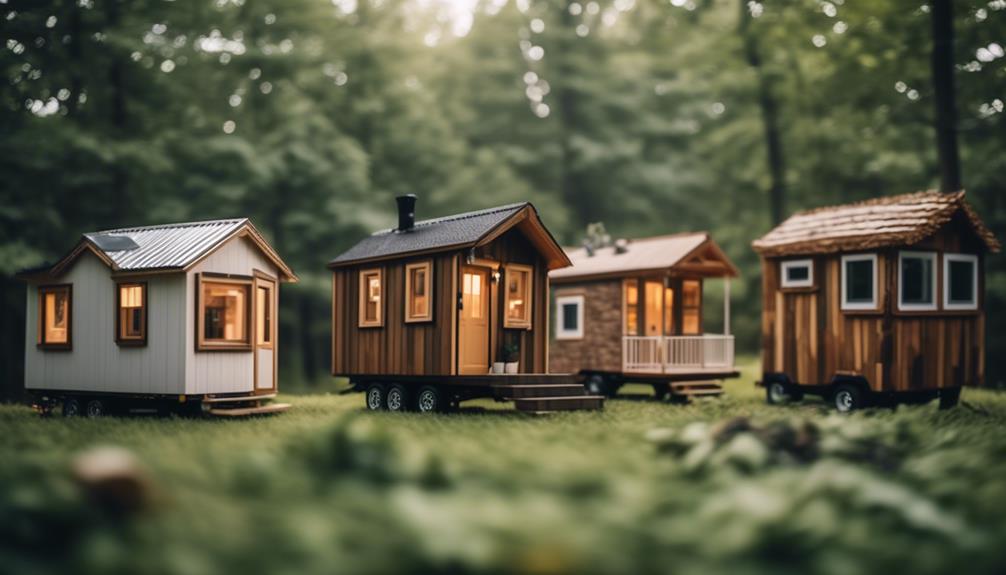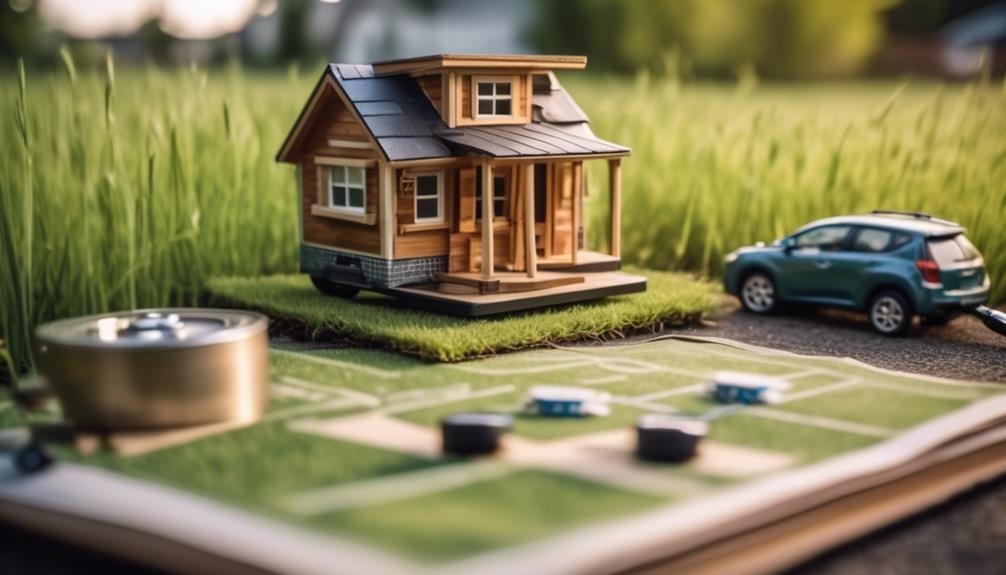You've decided to embrace the tiny house movement in Ohio, where the only thing larger than the cornfields are the legal hurdles you'll have to jump.
As you dream of a simpler, clutter-free life in a home no bigger than a tool shed, you may find the state's building codes less than accommodating. They seem to have been drafted by giants, with minimum size requirements that dwarf your quaint blueprint.
Yet, there's a silver lining in the form of mobile tiny homes on wheels, which may just roll right through those legislative loopholes. As you ponder whether you'll be planting your tiny roots in a permanent foundation or hitching your life to a set of wheels, you're left to navigate a complex landscape of zoning laws and safety regulations.
Stick around to unravel the intricacies of Ohio's tiny house conundrum, where the right knowledge could be the key to unlocking your miniature domicile dream.
Key Takeaways
- Tiny homes are not explicitly outlawed in Ohio, but the existing building regulations present challenges for those aspiring to live in compact dwellings.
- Ohio has stricter zoning and building laws for tiny houses, and each type of tiny structure is subject to varying regulations.
- The Ohio building code imposes a minimum size requirement of 950 square feet, which deviates significantly from the typical dimensions of tiny houses.
- Building permanent tiny houses in Ohio requires consultation with the state's building codes, while temporary tiny houses may have more lenient regulations and fall under different categories with distinct regulations.
Ohio's Tiny House Regulations
Navigating Ohio's tiny house regulations requires a clear understanding of the state's zoning and building codes to ensure legal compliance.
The tiny house movement confronts significant hurdles in Ohio, where zoning restrictions often don't accommodate the unique dimensions and spaces of these innovative dwellings. While the state doesn't explicitly forbid tiny houses, its building code lacks specific provisions for them, creating a complex legal landscape.
To align with the movement's pioneering spirit, you'll have to scrutinize local zoning laws that dictate the minimum square footage and land use.
Moreover, the subtle nuances in categorizing your tiny abode—be it a permanent foundation or a mobile structure on wheels—can pivot your project from a zoning violation to a compliant residence. Precision in planning and a proactive approach to these regulations are imperative.
Permissible Tiny House Types

When considering a tiny home in Ohio, it's essential to understand which types are permitted under the state's stringent regulations. Zoning restrictions and local codes dictate the possibilities for establishing your compact living space. You'll find that mobile home options offer a form of flexibility within the legal framework.
Here are key points to consider:
- Zoning laws may accommodate mobile tiny homes more readily than permanent foundations.
- Accessory Dwelling Units (ADUs) might bypass some zoning challenges.
- Certified RVs can qualify as legal tiny homes on wheels.
- Modular homes often comply with statewide building codes.
- Custom tiny houses must adhere closely to local building regulations.
Your innovative spirit can thrive within these parameters, but precise adherence to Ohio's legalities is paramount.
Building Code Compliance

Understanding which types of tiny houses are permissible in Ohio sets the stage for tackling the complexities of building code compliance that you'll face in your construction journey.
Navigating building code challenges is crucial, as Ohio's regulations impose a minimum size requirement that far exceeds the typical tiny house dimensions. To align with these standards, you must ensure your tiny abode meets foundation, structural integrity, insulation, and safety specifications.
The impact on the tiny house movement is tangible, as these stringent requirements may stifle innovation and deter some from pursuing tiny living.
Yet, with precise planning and adherence to the codes, crafting a legally compliant tiny house in Ohio is achievable, maintaining the balance between innovation and regulation.
Permanent Structure Guidelines

To ensure your permanent tiny house in Ohio stands on solid legal ground, you'll need to meticulously adhere to the state's building codes that cover everything from foundations to fire safety. The consultation process with local authorities can't be skipped; it's crucial to understanding the nuanced foundation requirements specific to your situation.
Here are key points to keep in mind:
- Engage in a thorough consultation process with building officials.
- Adhere strictly to foundation requirements for stability and safety.
- Ensure compliance with fire safety regulations for permanent structures.
- Familiarize yourself with egress, insulation, and utility codes.
- Obtain necessary permits to validate your tiny house as a legal dwelling.
Your innovative spirit combined with precise adherence to these guidelines will pave the way for your tiny house project.
Temporary Housing Rules

While permanent tiny houses in Ohio require strict adherence to building codes, the rules for temporary tiny homes offer a different set of parameters to navigate. You'll find that temporary housing regulations can be less stringent, but they're not without their challenges for tiny houses on wheels.
| Criteria | Permanent Tiny House | Temporary Tiny House |
|---|---|---|
| Building Codes | Strict adherence required | Less stringent, varies by locality |
| Foundations | Mandatory | Not always required |
| Mobility | Fixed location | Often on wheels |
Analyzing the legal landscape, it's clear that while you have more leeway with temporary structures, ensuring compliance with local ordinances is key. Innovators like you must stay informed of these nuances to successfully integrate tiny living solutions within Ohio's regulatory framework.
Frequently Asked Questions
How Does Ohio's Tax System Apply to Tiny Houses, and Are There Any Tax Benefits or Exemptions for Tiny House Owners?
You'll face Ohio's tax system without specific tiny house benefits, but zoning variances or meeting construction standards might offer some relief. No direct tax exemptions exist, yet innovation could pave the way.
Can Tiny Houses in Ohio Be Used as Legal Rental Properties or Airbnb Units, and What Additional Regulations Might Apply?
You can rent out tiny houses as Airbnb units in Ohio, but you'll face zoning restrictions and must ensure proper utility connections. Be precise; regulations vary, and innovative solutions are essential for compliance.
What Are the Challenges and Processes for Obtaining Financing or Insurance for a Tiny House in Ohio?
You'll face financing hurdles due to non-traditional property status, requiring creative solutions. Insurance options are limited but evolving—research and persistence are key to securing coverage for your innovative tiny house.
How Do Local Municipalities in Ohio Handle the Integration of Tiny Houses Within Existing Neighborhoods, and What Are the Implications for Property Values?
You'll face zoning challenges as local municipalities weigh tiny houses' impact on neighborhood dynamics and property values. It's a delicate balance between innovation and preserving community character.
Are There Any Advocacy Groups or Initiatives in Ohio Working Towards More Tiny House-Friendly Legislation, and How Can Individuals Get Involved?
You can join the Tiny House Movement's push for change by engaging with community groups advocating for more flexible laws. Your involvement can help drive innovative legislation tailored to tiny living enthusiasts.
Conclusion
So, you're sizing down in Ohio, where the tiny house rulebook is thicker than the walls of your would-be home.
Navigate the code labyrinth, dodge the square-footage minotaurs, and maybe, just maybe, you'll park your pint-sized dream on a loophole.
Remember, in the Buckeye State, your home's wheels might just carry more weight than its foundation.
Happy building, and may the legalities be ever in your favor—or at least amusingly navigable.

